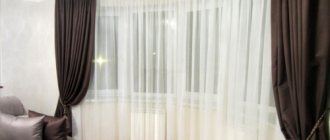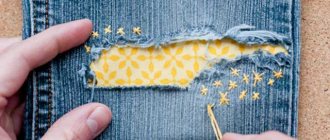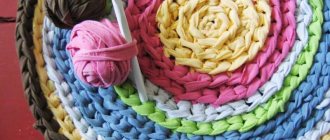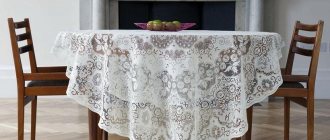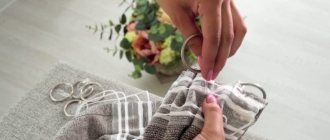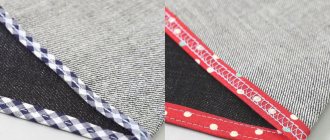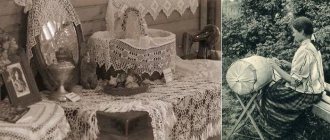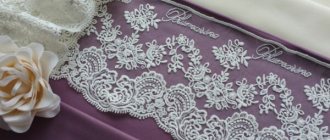Secrets of sewing lace
Dresses and blouses decorated with lace look airy and certainly attract the eye. However, sewing openwork lace onto products is not so easy. If you do this work, do it with the utmost care and precision, because the first glance of every person you meet falls on the lace.
By following the advice of experienced craftswomen, you will do this job correctly:
- Wash the linen because it can shrink and tighten the fabric. To preserve the relief, lay it “face down” on a soft surface and go over it with an iron. You can simply iron it with a steamer.
- When sewing the decoration simply to the fabric, place it overlapping the edge of the fabric, baste it, and sew it on a zigzag machine. Always match the threads to the tone of the openwork.
- If you are making lace gathers, then first make them on the lace, then baste them to the product and sew them on a machine with a zigzag seam.
- You can make folds on the lace ribbon. Choose a base with an alternating pattern, lay out the pleats according to the pattern, baste, and then machine sew.
How to sew lace elements together:
- Take the base with a reserve, then cut out the design along the contour.
- Place one piece on top of the other so that the pattern on one piece matches the other.
- Fasten with needles in different places, baste along the entire contour, and then sew with a zigzag. You can do it manually, since the stitching area will be small.
sewing lace using the “Hong Kong” method
Sewing lace is one of my favorite things. It is akin to a puzzle - each type of lace requires an individual approach, and the joining technology has to be thought out to the smallest detail “on the shore”.
Lace is an expensive material, which gives the tailor additional drive when cutting and sewing. Sometimes it seems that we are sewing air - however, why “it seems” - that’s the way it is.
There are many ways to process lace products, one of the most interesting is the so-called “Hong Kong” method, when the lace parts are connected simultaneously with the lining parts. But “Hong Kong” can be performed in different ways!
The classic method looks like this (pages from Lynda Maynard’s book “The dressmaker's handbook of couture sewing techniques”
Its general meaning can be characterized by the “principle of the French seam”.
Preparing the details
- Cut out congruent details from lace and lining
- Glue tensile sections if necessary. This is especially true for the neckline and armholes. In my example, the lace sections were glued with dublerin on a chiffon base (0.5 cm strips). Here the color of the dublerin does not conflict with the base of the fabric and lining and will remain invisible. You can glue the sections of the lining, not the lace, as you see fit.
- Baste the parts, try them on. Achieve a good landing! It is at this stage that we must gain confidence that we will no longer need corrections in the cut and fit, because after stitching the adjustment will be very difficult. Now we need to leave even allowances for processing the seams. For me they are 1.2 cm (0.5 + 0.7) for the side, relief cuts and armholes, 0.7 cm for the neckline.
Pin together all the cut pieces “face to face” in pairs. Stitch them together at a distance of 0.5 cm from the cut (neck -0.7 cm). Stitch length – no more than 1.5mm.
Here you will have to decide for yourself which sections to grind and which ones to leave unstitched. We need to think through the further technology of assembling the dress - here it is impossible to give exact recommendations on what exactly we sew on and which edges we leave free for connecting them in the next stages.
I have stitching: all raised, side cuts and neckline. Unstitched: armholes, shoulder seams and bottom of the dress.
- On side and relief seams: cut the allowances in the rounded areas, turn the parts right out. Sew the sewn edges with oblique stitches and iron.
- Neckline: Iron the lace allowance to the lining allowance. From the face, stitch to the edge along the lining. cut in steps, press back.
Dress assembly:
- Types of lace, what kind of lace there is
- The dress should be assembled in the usual way. Now we have all the parts with finished edges according to the French seam principle, with allowances of 0.7 cm. Sew the raised and side seams. If there are waist darts, then at this stage it is very convenient to sew them in, grabbing both layers of fabric.
- Press the seams.
- Adjust the dress! Fold the left and right sides, carefully connect and check the symmetry. Trim armholes and shoulder seams if necessary. Exception: we skip this step if the figure has individual asymmetry, which was taken into account during the fitting.
- Connect the shoulder seams: “face to face” in pairs: lining to lining, lace to lace. Sew on a sewing machine. Iron, cut in steps and turn out.
- Sweep the neckline with oblique stitches.
- Sew a zipper into the back seam: reinforce the lace section with double stitching, sew in the usual way, close with lining
- My dress had additional elements - lace godet wedges, single-layer. That is why I did not sew the side and raised seams down to the bottom, and sewed the gussets later between the layers of lace and lining - at the initial stage, the customer and I had doubts about their necessity in the design of the dress.
The sleeves and armholes are finished with cambric bias tape. The bottom of the dress and sleeves are finished with bias tape in one of the following ways.
What I like about this particular “Hong Kong” method: it gives flat seams at the joints of the parts.
Absolutely all cuts are cleanly earned, without thickening. The lace details are securely reinforced. And it is simpler than the classical method, in my opinion.
We will certainly look at other ways of working with lace in the following master classes.
How to lengthen a dress
The fashion for lace trim lasts for more than one season. If you are tired of a dress, then decorate it with sewing. You can also lengthen the product.
On a note!
To make the finish look especially beautiful, the fabrics must match in color or be contrasting. For a floral dress, choose decorative patterns to match one of the colors of the item's fabric.
You can sew to the hem in two ways:
- Openwork fabric is applied over the hem.
- The hem is sewn on top of the decor.
The openwork tape is cut with a margin (1-2 cm) to connect the parts. In the first case, lace is placed on the front side of the hem and a basting stitch is laid. A machine stitch is placed along the edge of the pattern.
In the second case, the openwork is applied to the bottom of the hem from the wrong side.
If you need to lengthen the dress, then choose a wide ribbon.
The lace fabric looks beautiful.
Selection of lace
An important step in the work is the correct choice of lace braid. Here it is necessary to take into account not only the decorative element itself, but also the dress to which it will be sewn. On some styles or materials, such an addition will look out of place, which will give a tasteless look to the entire ensemble.
For placement on the hem, it is recommended to focus on fabric textures. It is preferable to choose openwork ribbons with fine trim, which is located along the edge
It will come in handy when sewing.
The ratio of shades is also important. The best option would be black lace, since this color is universal and fits any palette.
When decorating a colorful dress, a ribbon in the color of one of the shades is suitable.
Sew openwork ribbon to the skirt
You can also adapt the ribbon to the skirt in two ways: on top of the hem and on the wrong side of the fabric.
Contrasting lace looks original.
The algorithm looks like this:
- Finish the bottom of the skirt with an overlocker, attach the openwork, and sew it on with a machine.
- Cut off the excess and process the cut with a zigzag.
- With knitwear it is better to do without a machine. Sew on a ribbon with a figured edge by hand, decorate the junction with the hem with beads, rhinestones, and thin braid.
Sew the decoration to the neckline. The easiest way is to find a sewing pattern that can be easily rounded. Place it along the neckline, pin it and sew it to the edge.
How to sew guipure on a machine?
You can sew parts together in different ways.
- Straight stitch, selecting the optimal stitch length and presser foot pressure.
- Zigzag - especially stretch fabrics.
- The method of superimposing one element on another.
- Double seam with closed cut.
For sewing non-stretch fabric, needles No. 75-95 are suitable, depending on the density of the material. And stretch guipure should be sewn with special needles for stretch or superstretch No. 70-80. Guipure is a delicate fabric. However, it is quite possible to master the intricacies of working with it.
Decorating clothes with lace
Any clothing can be updated if you decorate it with a piece of openwork. How to sew to shorts:
- Cut out a piece of decor, completely preserving the design.
- Make a slit or cut a piece of fabric along the side seam of the shorts.
- Attach a piece of decor, pin it in different places, and lay a basting stitch.
- Iron with a steam iron.
- Sew on a machine.
Decorate your blue jeans with white lace yourself. You will not buy such a beautiful thing in any store. In this case, the lace fabric must be placed from the inside out, then stitched along the entire perimeter.
On a note!
You can stitch the trim to the sleeves anywhere: along the bottom of the sleeve, along the shoulders, along the sleeve, in a word, as your imagination dictates. The procedure is the same as for the hem of the dress.
Contrasting trim on the sleeve will update and decorate any dress.
Updating a top or T-shirt with patterned fabric is easy. First, make folds on the lace ribbon, then sew it to the top.
- The folds can be ordinary, which go in one direction.
- Counter, when the canvas is folded towards each other.
- Bow ones. The material is also rolled up on both sides, but only in the opposite direction from each other.
If you fasten together several types of openwork material and sew it to a blouse, the product will take on a more elegant look.
Recommendations
Many users recommend choosing high-quality material. It will depend on him whether the dress can maintain its attractiveness for many years or not. You should definitely give preference to materials with already processed edges that do not have hanging ribbons.
Choosing quality material as basic advice
If the edges of the product are not processed, this must be done, since lace products, and especially dresses, have the ability to have holes and climb. This is especially true for fabrics of synthetic rather than natural origin.
Proper processing is the key to creating a beautiful product
Of course, when performing any work, you should follow the instructions. If you have chosen a model from a textbook, then you should not show independence at first with your familiarity with openwork decor.
Note! The instructions must be followed completely. Then you can create a product that will not only have a beautiful appearance, but also maintain this appearance for a long time.
If the decision has been made to process the edges of the dress in some unusual way or to make an entire hem out of lace, then the key to success in the undertaking will be good ironing before darts and decoration. For example, this will be especially useful if the lace strip is placed on the outfit in a triangle or other shape.
It is also worth remembering that before decorating, the lace must be decatified. To do this, the tape must be wetted and dried naturally. A steam generator unit will help make the work easier. Such actions will help avoid rapid shrinkage.
There is no need to stretch the lace fabric at the time of sewing. Then the material can be made unevenly or spoil the hem of the outfit, and an unsightly fold is added.
Ironing the product before final sewing as a tip
The textured edge must be sewn on by hand. To decorate the edge, you need to put the sewing machine aside and start working by hand. It is important to pay attention to the threads. If the ribbon goes under the hem, you need to match it to the dress.
Note! The lace insert can be used not only to decorate the dress. They can significantly change the appearance of a product with its length. Decorating the hem can be done independently, without using special skills and spending minimal personal time.
Overall, decorating the hem of a dress with lace is a great idea. All you need is to choose the right material, based on the criteria of quality and strength. Next, you can decorate it under the hem, on top of the dress, or in several layers. There is an option to make the hem out of lace. As for useful tips, every novice needlewoman should know that the quality of the sewn product and its service life will depend only on the quality of the material and the correctness of its processing.
